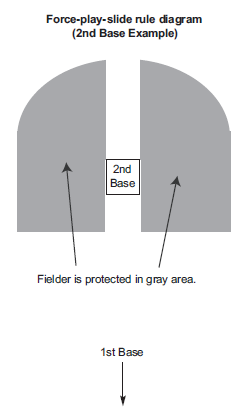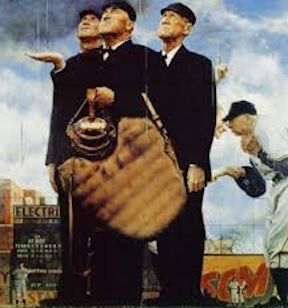 Force Play Slide Rule / Illegal Slide
Force Play Slide Rule / Illegal Slide
There has long been a force-play slide rule at most levels of amateur baseball, and at all levels there is a clear definitions of legal vs. illegal slides. The potential for collisions and serious injuries, as well as for malicious behavior, is so prominent in sliding (particularly in force-play and potential double-play situations) that amateur baseball, from Little League through NCAA, enforces strict rules. Only recently has Major League Baseball followed suit (see the blog post, MLB’s Chase Utley Slide Rule & Demise of the “Neighborhood” Play).
 Force-play/slide rules differ across the various leagues. We'll cover the following:
Force-play/slide rules differ across the various leagues. We'll cover the following:
But before going on, let's debunk a common misconception about slide plays in general, and the force-play slide rule in particular: There is no requirement (in any rule set) that a player must slide. This myth seems impossible to kill as coaches bring it up constantly. Sliding is discretionary. Period.
That said, if a player elects to slide, the slide must be legal. This applies in all rule sets.
NCAA (college) slide rule
The NCAA slide rules are captured in NCAA Rule 8-4 (from which the image above is taken). In my view, NCAA provides the most sensible and common-sense approach. In a nutshell:
- On a force play, the runner must slide on a line directly between the bases; it is allowable to slide through the base if the runner's momentum carries him beyond the bag.
- If carried through the bag, contact with the defender beyond the bag is allowable so long as the slide is legal in all respects. Note that contact "on top of" the bag is legal, even if the slide is a "pop-up."
- A runner may slide to either side of the bag so long as he chooses a side away from the fielder and avoids making contact or altering the play of the fielder.
- Rule 8-4(c) outlines the five actions that make a slide illegal.
- The Penalty section outlines penalties for each of the five illegal slides. Note that the penalty section (3) stipulates that an umpire can judge a runner's slide or resulting collision to be "flagrant"; in such cases, the offending runner is to be ejected.
Note that NCAA also has a strict rule regarding collisions at home plate. See NCAA Rule 8-7 (the "collision rule").
NFHS (high school) slide rule
The NFHS rule book first defines legal and illegal slides in NFHS Rule 2-32. It further rules on illegal slide behavior in Rule 8-4-2(b). The NFHS rule is more restrictive than the NCAA rule:
- As with NCAA, high school players must slide "on the ground and in a direct line between the two bases," or "within reach of the base with either a hand or a foot" on the side of the base away from the fielder.
- Significantly, the runner is out if he slides beyond the bag and "makes contact with or alters the play of the fielder." In other words, contact is not required if the runner slides past the bag and "alters the play of the fielder." However, the runner is allowed to slide through and beyond the base at home plate.
- The rule goes on to list actions that make a slide illegal, including kicking or slashing at the fielder, raising a let higher than the fielder's knee, and so forth.
Related NFHS rules:
- Rule 2-21-1(b) – Malicious contact (offensive interference).
- Rule 3-3-1(n) & Penalty – Malicious contact; offender ejected
Little League slide rule
The Little League slide rule is captured in Rule 7.08(a)(3-4).
Again, there is no "must-slide" rule in Little League. The rule simply states that runners must either "slide or attempt to avoid" a fielder with the ball who is attempting to make a tag. Of course, the runner is free to reverse direction.
For malicious or injurious action on the part of the runner (taking out the catcher, for example), Little League relies on unsportsmanlike conduct rules to penalize malicious behavior; there is no "malicious contact" rule as such.
Pony Baseball slide rule
Pony baseball plays OBR with added safety rules. Surprisingly, though, Pony provides no safety rule around sliding on force plays or potential double plays. Therefore, OBR Rule 6.01(j) applies to all levels of Pony baseball.
Major League Baseball slide rule
Major League Baseball has recently readdressed the issue of ensuring safety for middle infielders on double-play attempts in OBR Rule 6.01(j), as well as collisions at home plate in OBR Rule 6.01(i).
MLB begins by defining a "bona fide slide" in 6.01(j), and then outlines actions contrary to a bona fide slide that constitute interference. A bona fide slide requires that the runner:
- begins his slide (i.e., makes contact with the ground) before reaching the base;
- is able and attempts to reach the base with his hand or foot;
- is able and attempts to remain on the base after completion of the slide (except at home plate); and
- slides within reach of the base without changing his pathway for the purpose of initiating contact with a fielder.
A runner, then, is exempt from being called out for interference so long as the slide is bona fide; nor shall a runner be liable for interference if the fielder is positioned in the runner's "legal pathway to the base."
The runner loses his exemption from interference if he "intentionally initiates (or attempts to initiate) contact with the fielder by elevating and kicking his leg ...," or by throwing a "roll block."
Contact with the fielder is allowed so long as it occurs within the context of a bona fide slide, and so long as it does not include deliberate actions intended to disrupt a play by the fielder.

